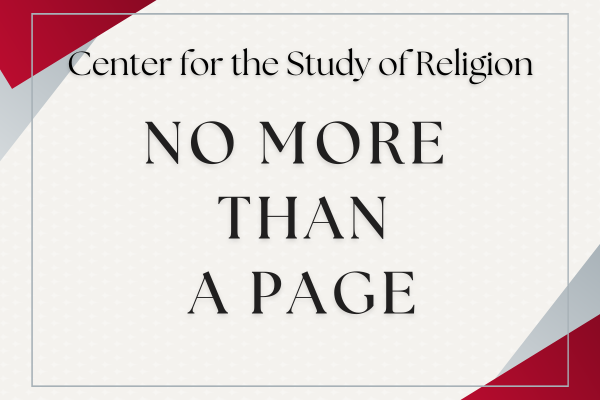
Please join us for the next installment in our "No More Than A Page" series. This series gives an opportunity for faculty and advanced graduate students to receive feedback on their research in process. Presenters provide attendees with a one-page summary of their current research and attendees engage in a lively discussion.
Shurouq Ibrahim will detail the events of a research trip to Cairo, Egypt in December 2023. She'll reflect on conversations she had with different Muslim Egyptian women about their knowledge and perceptions of Rabi'a al-Adawiyya, the first female Sufi Saint.
Shurouq Ibrahim is a Ph.D Candidate in the Department of Comparative Studies and has completed a graduate minor in Women’s, Gender, and Sexuality Studies (WGSS). Shurouq is currently the Graduate Research Associate for the Center for the Study of Religion and an instructor in the Department of Near Eastern and South Asian Languages and Cultures. Shurouq’s research interrogates individual, vicarious, and cultural trauma in modern and contemporary fiction. Her current project examines the intersections between cultural trauma, gendered subjectivity and the spiritual-supernatural in modern Arabic and Anglo Arab literature and film. She draws on decolonial trauma theory and feminist frameworks to analyze narratives written against the backdrop of violent collective experiences like colonialism and war. Shurouq is particularly interested in gothic tropes such as the qarina/spirit-double, the monstrous feminine, haunting and embodied abjection.
This event is free and open to the public. Hosted by the Center for the Study of Religion, the Department of Comparative Studies and the Humanities Institute.
Shurouq's Page
Walking in the (Egyptian) City: The Specter of Rabi’a the Saint and the Ghosts of the Arab Spring
In December of 2023, I visited Cairo, Egypt for three weeks. My trip was motivated by my desire to understand how the memory and spiritual legacy of the female Sufi Saint Rabi’a al-Adawiyya resonates among Cairene women today. Although Rabi’a al-Adawiyya (also called Rabi’a of Basra) is said to have been born in Iraq in 713AD (d. 801AD), she has historically been highly revered in Egypt; her life story and divine love poetry have been broadcast on national television, recited on the radio, and taught in schools (in different contexts and for different purposes). Moreover, because Cairo is 1) home to a prominent mosque named after Rabi’a, 2) a central hub for Islamic scholarship, and 3) the “Hollywood of the Arab World” (producing one of only a handful of international feature-films representing Rabi’a’s life), I decided to visit Cairo and interview women about their perceptions of the Saint. I planned to first visit the Rabi’a Mosque. Upon my arrival, I learned that the mosque was not open to visitors, so I visited other mosques in the city—over 10 mosques including the historic Al-Azhar Mosque—and several libraries and museums. In addition, I was invited to attend two religious learning circles (halaqat) on the Qur’an and the life of the Prophet Mohammed. These lessons were specifically for women and led by women. In the end, I interviewed 29 practicing Muslim women across these different spaces and asked them what they knew or appreciated about Rabi’a the Saint. As I spoke to each of these women, I discovered that the perceptions of Rabi’a varied primarily according to age and education level. While the older women (50s and over) and the women who held higher education degrees largely referred to Rabi’a as a pious woman with (supernatural) gifts, as a role model to Muslim women, and as a spiritual figure whose life and poetry should be studied by all Muslims today, the younger women mostly associated Rabi’a with a place, the mosque and square named after her. The responses of this second group—perhaps inadvertently—politicized Rabi’a and her spiritual legacy because they would link her name to the traumatic events of August 14, 2013, when around 1000 Egyptian protestors were killed in Rabi’a al-Adawiyya Mosque and Square. With every conversation, I realized that the name “Rabi’a” has come to mean different things to Cairenes post-Arab Spring.
In my dissertation chapter, “Walking in the (Egyptian) City: The Specter of Rabi’a the Saint and the Ghosts of the Arab Spring,” I reflect on the conversations I had with the women I encountered and contemplate my own walks through and experiences of Cairo. I propose that national trauma has transformed the city of Cairo into a doubly “haunted” space. The city is not only haunted by the suppressed collective memory of the Egyptian revolution and the tragic events of 2013 (the ghosts of the Arab Spring), but it is also haunted by the suppressed memory and knowledge of Rabi’a as an important spiritual figure (the specter of Rabi’a). Here, I rely on psychoanalyst Jean Laplanche’s notion of the enigmatic address, a “communication situation” in which meaning is both marked and obscured, and semiotician Roland Barthes’ postulations on myth and the ideological underpinnings of cultural signs and symbols. I argue that the Rabi’a Mosque itself is an enigmatic signifier—while the mosque is meant to be a kind of memorial for Rabi’a the Saint, it (also) signals to a collective national wound.
A PDF of this NMTAP is available by request. To request a copy, please email religion@osu.edu.
The Humanities Institute and its related centers host a wide range of events, from intense discussions of works in progress to cutting-edge presentations from world-known scholars, artists, activists and everything in between.
